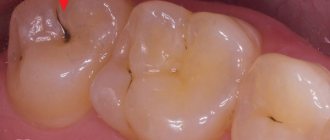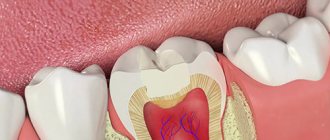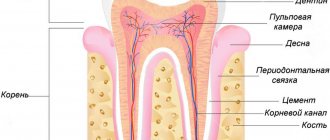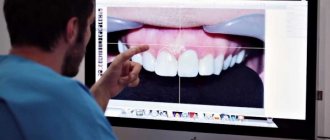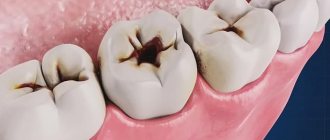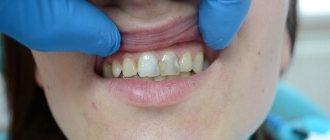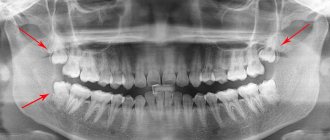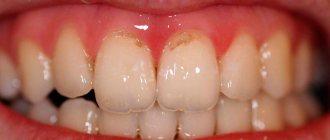Early detection of caries is the main and priority task of the dentist. Using a caries detector and a high-tech intraoral camera VistaCam IX, detection of the disease is possible at an early stage, in the form of a spot. If detected and treated in a timely manner, such a case will not require grinding off the hard tissues of the tooth and opening the cavity.
The appearance of a caries detector in the dental field has improved the quality of early diagnosis and treatment of caries. When using this technique, the affected areas of the enamel are stained. The boundaries of the carious spot are clearly identified, which contributes to the early and most effective treatment of caries.
Patients of the innovative dental clinic "Implantmaster" in Moscow have the opportunity to use the latest digital caries detector - the VistaCam IX intraoral camera. The camera has a wide range of capabilities - from detecting the initial stage of caries on visible surfaces to determining the process in the interdental space, invisible to the eye. Our specialists regularly improve their skills in the best clinics in Europe, participate in scientific conferences and symposiums. We are accustomed to solving complex problems in the shortest possible time, setting loyal prices for the services provided.
Next, we will tell you in more detail about what caries detectors are and what types there are. You will also learn about the VistaCam IX intraoral camera and its benefits. Let's take a closer look at the stages of diagnosing teeth with a caries detector.
Get a consultation
We will answer all your questions before visiting the clinic!
+7
Online registration
Content
1 What is a caries detector?
2 Types of caries detectors
3 Intraoral camera VistaCam IX 3.1 Possible applications of the intraoral camera
3.2 Benefits of the VistaCam IX intraoral camera
3.3 Stages of diagnosing teeth with a caries detector
4 Caries marker
5 Cost of diagnosing teeth with a caries detector
When is prosthetics indicated?
Installing a crown on a tooth is a necessary procedure in situations where the patient:
- the tooth is destroyed as a result of injury, abrasion of enamel or carious lesions,
- extensions, fillings and other treatment methods are not possible,
- the root remained intact.
Some defects, including discoloration of the enamel, lead to an unaesthetic appearance of the entire dentition. The crown will protect the tooth walls from external impacts. Tooth mobility is caused by various periodontal pathologies. In this case, the use of temporary crowns is considered, which make it possible to strengthen the teeth and make them more stable. Crowns are also placed on healthy teeth, which act as support for defects associated with the installation of bridges and dentures.
What is a caries detector?
Initially, dentists examined the structure of tooth tissues during a visual examination using probing with a sharp instrument. It is not always possible to detect damage in the initial stages in fissures or between teeth. The method is not accurate, especially in difficult situations. Very sharp tools and excessive pressure can cause harm. Probing may even be painful. To make the diagnosis accurate and painless, caries detectors .
What substances does the caries marker consist of?
A caries marker is a diagnostic, not a therapeutic, tool that can only be used by a dentist. This is a professional technique that allows you to establish an accurate clinical picture and adequately determine the scope of intervention. Our clinic uses the Voco caries marker (Germany), which includes:
- propanediol – a solvent of organic compounds of natural origin, facilitating the penetration of dye into fabrics;
- sodium DDC is a retention reagent, the high stability of which ensures the retention of pigment in tissues;
- eosin-B is a red pigment of an acidic nature, capable of staining at the cellular level;
- distilled water.
Reference. In addition to red caries markers based on fuchsin (rosaniline hydrochloride - green crystals, aqueous solutions of which have a purple-red color), there are blue caries markers based on the aniline dye methylene. And the American caries marker Sable Seek from the Ultradent company colors caries-affected tooth tissues green. There is no fundamental difference between caries markers of different colors.
Types of caries detectors
There are 3 types of caries detectors: chemical, optical and laser.
Chemical
These are caries markers. When the active substance (acid fuchsin or methylene blue) is applied to tooth tissue, a chemical reaction occurs that stains areas susceptible to caries.
Optical
Diagnostics are carried out using a computer. Light waves with a length of 405 nanometers are produced. Depending on the condition of the tooth enamel, the reflection of light is different. A specialized program on a computer analyzes the data and produces a color picture, where the boundaries are clearly defined and at what stage the development of the carious process is.
Laser
The mechanism of action is the same as that of optical caries detectors, but instead of light a laser beam is used. Laser indicators are expensive to use.
General information
The terms “caries detector” and “caries marker” are different. A marker is one of the types of detectors, but some dentists consider these definitions to be synonymous.
Detector is a broad concept that covers special preparations, devices and technologies that detect caries using other methods.
A synonym for a marker is the term “indicator,” which increases the likelihood of diagnosing a disease. The drug stains carious lesions at any stage of development, including the spot stage. The substance penetrates to the depth of the affected tissue, helps to detect pathology when eliminating necrotic areas of teeth.
Our team of doctors
Maxillofacial surgeon, Implantologist
Bocharov Maxim Viktorovich
Experience: 11 years
Dental surgeon, Implantologist
Chernov Dmitry Anatolievich
Experience: 29 years
Orthopedist, Neuromuscular dentist
Stepanov Andrey Vasilievich
Experience: 22 years
Endodontist, Therapist
Skalet Yana Alexandrovna
Experience: 22 years
Orthopedic dentist
Tsoi Sergey Konstantinovich
Experience: 19 years
Dentist-orthodontist
Enikeeva Anna Stanislavovna
Experience: 3 years
Application of KaVo DIAGNOcam laser caries diagnostic technology in pediatric practice
Most failed therapeutic treatments in pediatric dentistry are due to an initially incorrect approach to planning. Very often, for various reasons, without imagining the real extent of tooth decay, the pediatric dentist immediately begins treatment.
The problem of diagnosing caries in pediatric dentistry
The stories of parents who came to sanitation of a child under deep sedation sound strikingly similar: “We had a small black dot on the chewing surface of a back tooth. The doctor examined him and said that the child would not need anesthesia. When we started treatment, the cavity was actually deep, and the child closed his mouth halfway through the procedure. On the next visit he did not sit in the chair. Unfortunately, such cases in pediatric dentistry have become the norm rather than the exception. How can you explain the reason for this situation? The answer is quite obvious - this is an incomplete diagnosis, leading to an unreliable diagnosis. There is no point in explaining that the planned treatment ultimately turns out to be incomplete or insufficient. As before, many doctors who begin therapeutic treatment rely only on external, visual diagnostics, without additional research methods, although X-rays have long been included in widespread practice. What reasons force pediatric dentists to take unnecessary risks? Let's not forget that we are now talking about small patients who require more careful and delicate treatment. Most often, the reasons turn out to be purely psychological issues or insufficient communication with the patient or his parents - a correct explanation to them of the reasons and the need for therapeutic manipulations. The most common reasons for refusing an X-ray examination:
- The doctor’s lack of understanding of the value of x-ray examination as a diagnostic tool and the unpleasant consequences for the patient in case of incorrect diagnosis.
- Parents' refusal of treatment due to fear of X-ray exposure of the child.
- The child’s refusal to undergo the examination (the reasons can be very different, and even the most competent doctor with the right approach is not always able to persuade the child to undergo radiography).
- The financial component of an x-ray examination, which can be associated both with additional costs and with the uncertainty of the child’s parents about its real need.
- Additional complexity as a separate procedure that requires a lot of time, sometimes incompatible with the intensity of the doctor’s appointment.
The correct solution to the issue of high-quality and reliable diagnostics in pediatric dentistry is the device that is as simple as possible, quick to use and does not expose to x-rays. It is important that it does not frighten the child and, of course, shows in detail the extent of damage to the hard tissues of the tooth. A successful diagnostic solution is offered by one of the most famous and reputable manufacturers of dental instruments and equipment, KaVo. Their product really inspires interest and trust. DIAGNOcam is the first high-quality solution for me, which has greatly changed my attitude towards diagnosing carious lesions. From the manufacturer's description it follows that the principle of operation is based on fiber-optic transillumination - essentially, it is laser illumination recorded using a digital camera. The internal structure of the tooth crown is displayed on the screen in real time. The work process is simple and does not require additional training; the instructions describe in detail all the preparatory steps. The first step is to install software on a personal or clinical computer, with which it is possible to work with images and store research results, which is especially convenient for long-term observation: images can be supplemented with the medical record of each small patient.
The principle of operation of DIAGNOcam is based on fiber-optic transillumination - in fact, it is laser illumination recorded using a digital camera. The research procedure is absolutely painless and does not cause negative emotions in children. The process itself is completely displayed on the monitor, which is an excellent format for a visual presentation of possible carious lesions for parents. In my experience, carrying out such a diagnosis motivates parents to be more attentive to caries prevention and professional hygiene for a more accurate diagnosis (although it is not necessary for a study with DIAGNOcam), and therefore for further treatment. Another advantage is the ease of interpretation of the result. In most cases, the parents themselves, seeing the image on the screen, say: “Yes, I see this caries very clearly.”
A huge advantage of DIAGNOcam for pediatric dentistry is the ability to see approximal caries even in the initial stage, when there are no visual signs of the onset of the disease in the oral cavity. Motivating parents for an X-ray examination in such a situation is the most difficult task for a doctor. Caries will be detected already at the moment when the upper enamel wall of the carious cavity collapses and it becomes visible. Here any mother will have a natural question. How could a qualified dentist not notice this if the examination was carried out two weeks ago? Such situations entail both the risk of discovering complicated caries in the patient at the next visit, and the most unpleasant thing for the doctor’s reputation - loss of patient trust.
In addition to the fact of the presence of caries, the ability of DIAGNOcam to assess its depth is very important. This especially applies to teeth with a preserved coronal part and point destruction along the fissure. Every doctor has found himself in a situation where, having directed parents to a filling within the enamel, we end up doing direct pulp coverage. For children, a very important issue is being resolved here about the need for anesthesia before treatment and the choice of a method for restoring the crown of the tooth.
Another advisable point is to conduct a study of the sixth teeth before the fissure sealing procedure for hidden caries for additional preventive diagnostics, the need for anesthesia and proper information to parents before treatment begins. From my experience, DIAGNOcam is still not an absolute replacement for performing radiographic diagnostics at a pediatric appointment, but if necessary, it significantly facilitates the motivation of patients to perform it.
A pleasant alternative to its use is to replace a series of bitewing radiographs during a routine examination, which significantly reduces the radiation dose to both the doctor and the child. If we talk about practical use, it is extremely simple and convenient, which is an important advantage in children's practice. The entire process takes place in the dental chair without moving and with the simultaneous presentation of the results to the patient’s parents. It allows us to more clearly plan treatment and predict its course, which is most important in children if we want to successfully complete treatment.
Clinical case No. 1
Absence of visual signs of carious process. Patient: girl Age: 4 years Preliminary examination: The patient has no complaints. The reason for visiting the dentist is to obtain a certificate of sanitation. According to the mother, the child had previously undergone preventive examinations, and she is absolutely sure that the oral cavity has been sanitized. Upon visual examination, all teeth are intact. Let's take a closer look at one of the segments of the lower jaw. Visually for the parents, all the teeth are healthy (Fig. 6).
Rice. 6. Visually healthy primary molars.
The mother refused targeted X-rays, not wanting to irradiate the child for no apparent reason. The result of the DIAGNOcam examination showed otherwise. The photograph (Fig. 7) shows the presence of a deep pathological process on the 4th tooth. To confirm the diagnosis, an X-ray examination was performed (Fig. 8). The presence of a carious lesion is clearly visualized on the contact surface.
Rice. 7. Pathological process on the primary molar during the study of Dagnokam.
Rice. 8. Pathological process on primary molars on x-ray examination.
Thus, we were able to detect hidden enamel destruction on the contact surface; the DIAGNOcam images served as a justified motivation for the patient, confirming the need for an X-ray examination. Now my mother is sure that a paid and “dangerous” x-ray examination is carried out not because “the dentist decided so,” but with an understanding of the need, as in the described clinical case. When reviewing x-rays and DIAGNOcam images in detail with parents, we pay attention to the depth of the carious process. Based on the results of the study from two sources, we clearly voice the need for anesthesia and further treatment.
Clinical case No. 2
The presence of caries on chewing surfaces. The patient is a 5-year-old boy. Complaints about the presence of carious cavities on the lower fifth teeth. When examining the oral cavity, cavities are identified in the distal fissures of the lower fifth teeth. Earlier, during the examination, the dentist carried out a diagnosis and made a diagnosis of caries 75, 85. No X-ray examination was carried out. In the parents' minds, the treatment will take 2 visits, probably without anesthesia. The cost is 2 fillings made of composite material per surface. In this situation, it is obvious that for high-quality treatment planning, we need to conduct an X-ray examination of all segments for hidden carious cavities and a real assessment of the situation in the mouth.
Having a series of images, we can clearly plan the scope of treatment by visit, draw up a financial plan for parents, and thereby provide a more predictable result. It often happens that the child’s next visit is postponed indefinitely for various reasons, and by the time treatment begins, the X-ray image becomes uninformative. The question arises about the need for a full X-ray examination on the first visit. DIAGNOcam also gives us the opportunity to plan treatment in a high-quality and detailed manner without unnecessary time spent at the appointment, financial costs for the patient and radiation exposure to the child. In Fig. 9, 75 and 85 teeth were treated.
Rice. 9. Oral cavity of a patient with carious cavities on molars.
Visually for parents, segments 7 and 8 have been sanitized. No X-ray examination was performed before treatment. In this situation, it is extremely difficult to motivate the mother for additional paid research after treatment has already been performed. In Fig. 10 - X-ray of the segment to be sanitation.
Fig. 10. Pathological process on primary molars on x-ray examination.
However, with the help of “Diagnokam”, already during the examination we can demonstrate on the monitor and voice the presence of lesions, proving the need for additional research. Conclusion: using Diagnocam at a child’s appointment significantly reduces the time spent on additional diagnostics for the child. Allows us to facilitate treatment planning and do it more accurately and efficiently, which is extremely important in children. Facilitates the motivation of parents for additional diagnostic methods. Shows the actual depth of the lesions.
In addition, the level of patient confidence increases when we, starting with the words “there may be a lesion on this tooth, and to find out for sure, we must irradiate the child,” move on to justifications, and the parent himself sees the presence of a process and can even receive research results by email. From all of the above, it follows that the use of “Diagnocam” at a children’s appointment not only helps the doctor in selling treatment and presenting the plan, but is also a serious diagnostic study that really helps us in everyday practice, and raises children’s appointments to a fundamentally new modern level.
Rice. 1. Carious cavity on the 55th tooth during visual inspection. Rice. 2. Carious cavity on the 55th tooth during the Diagnocam study. Rice. 3. Real picture of destruction after the start of preparation. Rice. 4. Healthy contact surface of teeth when examined by Diagnosticam. Rice. 5. Healthy dental surface on x-ray examination.
Intraoral camera VistaCam IX
The VistaCam IX intraoral camera is a digital device for obtaining dental images using various physical and optical methods, which make it possible to make an accurate diagnosis, as well as determine the location and extent of the lesion. The modular system of interchangeable nozzles helps to analyze the clinical situation from different angles. High image resolution and color rendering quality, high magnification, the use of advanced methods of UV fluorescence and infrared illumination, absolute safety for the patient and staff, have made the VistaCam IX intraoral video camera the most popular diagnostic device for the modern dentist.
Patients of the Implantmaster dental clinic have a unique opportunity to attend an appointment with our highly qualified specialists who use the latest technologies and equipment, including the VistaCam IX intraoral camera.
Possibilities of using an intraoral camera
The VistaCam IX dental intraoral camera has:
- Replaceable nozzles, which are quickly replaced and each has its own specific area of application;
- convenient location of on/off buttons on both sides;
- the ability to rearrange a convenient work surface;
- energy saving mode;
- digital data transmission.
1. Cam attachment for intraoral images.
- High-quality image transmission;
- uniform illumination of the working area;
- photo/video modes.
2. Macro attachment for detailing under high magnification, while maintaining image quality.
- Magnification 120 times.
3. Poly nozzle for polymerization of all modern composites.
- The presence of a soft start (gradual increase in light) for deep curing.
4. Proof attachment – diagnostic.
- Detection of plaque and analysis of the degree of carious lesions;
- fluorescence of cariogenic bacteria in the UV spectrum highlights places in the tissues and on the surface of the tooth in red, and healthy enamel is highlighted in green.
- The diagnostic result is assessed on a color scale with numerical values.
- 0 – 1.0 healthy enamel (green)
- 1.0 – 1.5 (blue)
- 1.5 – 2.0 (red) superficial caries (initial stage of enamel caries)
- 2.0 – 2.5 dentin caries (orange)
- 2.5 – 3.0 and deeper dentin caries (yellow)
5. Proxi head for detecting proximal caries.
- No harmful radiation;
- detection of caries between teeth, on contacts in the stain stage;
- Safe infrared radiation is reflected from caries-affected areas and is identified as lighter, opaque areas.
Benefits of the VistaCam IX intraoral camera
- At the same time, the consultation involves visualization of processes on the screen, creation of computer documentation and diagnostics. All this encourages the patient to trust the doctor.
- The proprietary camera system is a valuable assistant to the doctor during the appointment. The VistaCam IX intraoral video camera helps explain the need for treatment and professional cleaning.
- The intraoral camera in dentistry fully meets the requirements for clarity and quality of photographs when transferring data from the device to a computer.
- The presence of specialized replaceable nozzles is unique for a specific clinical case.
- An optical caries detector is a significant aid to the doctor during an appointment when determining the carious process.
- Caries and plaque are indicated by a color scale, supplemented by a digital value of 0-3, in a special computer program.
- Indispensable in detecting initial caries, as well as controlling the spread of plaque.
- The camera, ergonomic in shape, is functional when used in the workflow.
- It can be installed on almost any surface, and the standalone version can be used even without installing a PC.
- With the ability to be removed from the tip, the camera can be used without being tied to a specific point in the room.
- The motion sensor activates the device when picked up, and turns off when placed in place. This promotes efficient use of the device and saves battery power.
- Due to the absence of ionizing radiation, it is used at children's appointments, for pregnant women, and other categories of patients for whom the use of x-rays is undesirable.
Method of using caries detectors in practice
The procedure for identifying areas of the dentition affected by caries consists of a number of sequential actions:
- The doctor rinses the teeth and the areas between them with a water jet, then dries the teeth with warm air, which expands the pores and removes remaining water. This point is very important - thoroughly drying the surface of the tooth enamel determines how accurately the caries detector will subsequently color them.
- The doctor treats the teeth with a chemical dye using a syringe or pipette. The indicator is distributed evenly over the entire surface of the dentition.
- After 10 seconds (but no more) after applying the caries marker, the dentist washes off the drug, then dries the teeth again. As a result, only areas with carious lesions remain stained.
- Using a drill, the affected tissue is removed. After this, the doctor again applies the caries marker to the teeth, washes off and cleans the stained areas again.
- This algorithm of actions is repeated over and over again until the tissues stop staining, which indicates the absence of affected enamel.
Of course, the procedure is carried out gradually: as a rule, one or two teeth per session. And although the use of caries detectors somewhat reduces the speed of the therapeutic process, it significantly improves the quality of dental treatment.
Indicators allow for thorough cleaning of the enamel from carious damage and prevent possible complications. For example, if diseased tissue is poorly removed under fillings and crowns, secondary caries may begin to develop.
Our clinic
Dentistry "Implantmaster"
5.0 – 79 reviews
- Maly Sukharevsky Lane, 9, building 1, Moscow 115280
- Tsvetnoy Boulevard
- Pipe
- Sukharevskaya
- Mon-Sat: from 09:00 to 21:00; Sun: Closed
More details
Sign up for a consultation
Stages of dental diagnostics using a caries detector
The VistaCam IX intraoral camera is a multifunctional imaging system from Durr Dental that provides the doctor with valuable diagnostic support during the treatment process. The functionality of the camera, tip and interchangeable attachments simultaneously uses several methods for identifying carious lesions, increasing the accuracy of diagnosis and treatment plan. Disposable covers reliably protect the camera and patients without interfering with the operation of the optics.
1. An area that worries the patient or one that was noticed by the doctor during a visual examination, or a prepared cavity for further examination with a caries detector is determined.
2. A nozzle suitable for the stage of treatment is selected.
- For taking photos or recording videos, use the Cam attachment, which can shoot from any angle without glare or shadows.
- For deep detail, use the Macro attachment, which magnifies the image 120 times. The accuracy and quality of work increases.
- The Proof tip helps identify the location of early carious lesions that are not visible to the eye. Photo-stimulation of cariogenic bacteria is carried out in the UV spectrum. The brightness and color of fluorescence depend on their quantity, determining the extent and depth of the lesion. The attachment is used for the initial diagnosis of caries and for control during preparation. Plaque that turns pink motivates patients to visit a hygienist for cleaning.
- The Proxi attachment illuminates tooth tissue in the infrared spectrum, producing a b/w image. Healthy enamel appears transparent, while caries appears matte with white areas.
- The Poly attachment is used for polymerization of composites at the final stage of treatment.
3. The device is inserted into the oral cavity. The procedure is painless and harmless.
4. The camera is activated. There is a multifunction button on the handle of the device. When you press it, you can switch between photo and video modes. The accuracy of the work is ensured by the system's feedback to the operator through vibration of the tip.
5. A clear demonstration of the entire oral situation during the consultation makes the treatment plan sound, accurate and consistent. Promotes the formation of a trusting relationship between doctor and patient.
Purpose
Use the drug in the following situations:
– to determine residual areas after removal of necrotic areas;
– in order to monitor the result of treatment;
– to detect pathology in areas inaccessible to visual inspection;
– for the purpose of demonstrating foci of pathology to the patient;
– to identify cracks, chips on teeth and in adjacent areas;
– when determining a defect in the surface layer of teeth.
Instructions for use
The procedure for identifying a disease using chemicals consists of the following steps:
- The teeth are washed with water and dried. The intensity of the indicator color depends on the degree of dryness of the enamel.
- A coloring agent is applied to the surface of the teeth using a syringe or foam balls.
- After a few seconds (no more than 10 s), the drug is washed off with a stream of water. The affected areas take on the color of the chemical.
- Caries zones are treated with boron.
- A coloring agent is applied to the treated surfaces. The procedure is repeated until there is no reaction to the lesions.
When working with a caries marker, it should be taken into account that under its influence the color of plaque and tartar also changes. Therefore, care must be taken during tissue preparation.
The use of chemical markers helps remove affected dentin, which is fraught with tissue necrosis. The duration of the procedure of 30 minutes is justified by the result that prevents secondary caries under fillings and crowns.
Advantages and disadvantages
The advantages of detecting carious lesions using chemical indicators have been noted by dentists and patients:
– the boundaries separating the affected and healthy tissues are clearly distinguishable;
– a substance consisting of organic components is safe for the patient’s health;
– lesions are detected not only in superficial tissues, but also in root canals.
The disadvantages of using coloring preparations include:
– coloring of mineralized areas. There is a risk of using a drill to prepare areas that require only professional dental cleaning;
– the smear layer that appears during the grinding process is different in color and makes it difficult to visualize the affected area.
Security measures
The main problem when working with an indicator is the likelihood of staining healthy teeth when the drug is on dentin for more than 10 seconds. In practice, the time the detector is kept in the oral cavity is 6–7 seconds, which is enough to detect foci of caries. In addition, the following safety measures are taken:
- A small number of teeth are processed in a certain sequence.
- When obtaining results, the natural pink tint of dentin near the pulp, similar to the color of the marker, is taken into account.
- If the patient has an allergic reaction to propylene glycol, which is part of the detector, wash the mucous membranes with a stream of water.
• Remaining stains from the caries marker are removed with a swab soaked in vinegar.
Caries marker
A caries marker is a chemical that is used to instantly color plaque and carious areas.
The coloring pigment is applied by the doctor to the dried surface of the teeth. Penetrates into damaged areas of enamel and dentin, where mineral loss has occurred and the carious process has begun. In this case, healthy tissues and non-carious lesions are not affected.
Advantages:
- availability;
- visibility - the doctor shows the patient the full extent of the damage and the level of oral hygiene;
- residual caries is detected, which was not visible during visual inspection;
- economical - no additional equipment required.
Flaws:
- When interacting with the oral mucosa, local irritation may develop;
- There are natural low-mineralized zones in the teeth, they also become stained, this misleads inexperienced doctors;
- If accidentally contacted with clothing or skin, dyes leave stains that will be difficult to remove;
- The use of a caries marker for the frontal group of teeth is recommended with caution.
- Large amounts of dye may change the color of subsequent restorations if they are needed.
This type of caries detector is not used in the Implantmaster clinic. We use the VistaCam IX intraoral camera, which is the most advanced optical caries detector.
Treatment procedure for caries using a caries marker
Stage 1. Preparing teeth - rinsing with water, drying. The drier the surface, the more intense the color.
Stage 2. Applying an indicator to the enamel surface. Some people use special syringes, while others find it more convenient to work with applicators.
Stage 3. No later than 10 seconds later, the doctor rinses the teeth again with water to remove the paint from healthy areas. The affected tissue remains stained.
Stage 4. Removing caries using a bur machine.
Having removed the layer of tissue, the dentist repeats the staining steps, layer by layer destroying the affected areas. The session lasts until the doctor is convinced that the tissue has stopped staining. This suggests that caries has been completely defeated.
The indicators are practically safe, but patients with hypersensitivity may feel slight discomfort if the solution gets on the mucous membrane. These symptoms will quickly go away when the solution is washed off with water.
The cost of diagnosing teeth with a caries detector
When treating dental caries at the Implantmaster clinic, diagnosis with a caries detector is included in the cost of treatment.
Also, during comprehensive professional hygienic teeth cleaning, diagnosis with a caries detector is carried out free of charge .
Professional hygienic teeth cleaning under a microscope
9,600 ₽ -50% 4,800 ₽ + Dental diagnostics with caries detector
Until 01/31/2022 Submit a request
Treatment of caries by filling tooth surfaces
- Anesthesia
- Cavity preparation (preparation, medicinal treatment, application of a gasket)
- Filling with light-curing composite
- Grinding and polishing the filling
- X-ray images
Price : from 3,000 ₽ to 8,050 ₽, depends on the number of tooth surfaces affected.
Treatment of caries by placing a ceramic inlay “E-MAX” or “CEREC” or “EMPPRESS”
| from 20,000 to 28,000 ₽ |
Unsealing all tooth canals
| from 4,000 to 8,500 ₽ |
Filling all tooth canals
| from 6,500 to 11,500 ₽ |
| Removing a foreign body from a tooth canal (pins, fragments of instruments, etc.) | 3 000 ₽ |
| Application of medicinal paste into the tooth canals | 2 000 ₽ |
| Sealing tooth fissures | 2 000 ₽ |
| Treatment of caries without drilling the tooth using the “Icon” method | 3 000 ₽ |
| Complete restoration of a tooth with a light-curing composite (Tooth restoration) | 9 500 ₽ |
Author:
Diagnostics
To diagnose the disease, a visual examination is performed using a mirror. In cases of hidden caries, as well as to determine the depth of tissue damage, additional research methods are carried out:
- radiography;
- laser fluorescence;
- tooth microscopy;
- fissurotomy;
- electrometry (EDI);
- vital staining with markers.
X-ray
Using radiography, it is possible to identify foci of demineralization that have gone beyond the enamel-dentin boundary, i.e. medium and deep tissue damage. In this case, fissure caries in the image looks like a radiolucent, diffuse, dark area lying under the grooves and pits of the tooth.
The use of X-ray diagnostics in combination with a visual examination significantly increases the diagnostic reliability of caries, especially if the X-ray image was taken using a radiovisiograph.
Application of laser diagnostics
Laser fluorescence is based on passing a red laser beam through the tooth. Moreover, as the number of bacteria increases and the carious process deepens, dental tissues begin to fluoresce. This method allows you to differentiate a healthy tooth from one affected by caries, as well as from teeth in which secondary caries has begun under a layer of sealant.
Microscope
Teeth microscopy allows you to detect even minimal damage, including at the bottom of pits and depressions. In addition to the fact that the microscope is used for diagnostic purposes, it is indispensable for medical manipulations, because allows you to clearly see the boundaries of tissue damage and carefully remove them. In addition, working at magnification makes it possible to accurately apply sealant and properly seal fissures.
Fissurotomy
Fissurotomy is the “gold standard” for diagnosing fissure caries. The method involves minimally invasive (very gentle) opening of grooves and pits in order to visually confirm or refute the presence of hidden fissure damage, as well as the depth of the carious process. The opening of the grooves is carried out with a special thin fissure bur, which practically does not affect healthy tissue and “works” only along the grooves.
Special markers
The method is based on the ability of low-mineralized tissues to absorb dyes (caries markers, caries detectors). Staining of tissues indicates that they are affected by caries. However, markers do not allow the determination of dentin caries in deep closed fissures and can accumulate at the mouths of the recesses due to food debris and the presence of plaque, which reduces the versatility of the method.
Hardware diagnostics of EDI
Electroodontodiagnosis, or electrometry, allows you to identify teeth with reduced tissue mineralization. The worse the condition of the dental tissues, the higher the electrical conductivity of the tooth. Thus, a tooth with a stopped initial enamel lesion has an electrical conductivity of 0.1 μA, an active state of initial caries - 10 μA, medium and deep caries - from 20 to 100 μA.
Self-diagnosis
Self-diagnosis of fissure caries is relevant in cases of an open process, i.e. when the enamel lesion is not located deep in the grooves, but is noticeable to the naked eye. Upon examination, dark stripes or spots located on the fissures will be visible.
The intensity of coloring may vary depending on the stage of the carious process. So, at the initial stages they have a whitish, yellowish or creamy tint. Later, the color of the fissures becomes darker, even black. If you notice such darkening, it is recommended to consult a dentist, especially if, in addition to visual disturbances, there are complaints of pain or discomfort in the tooth.
